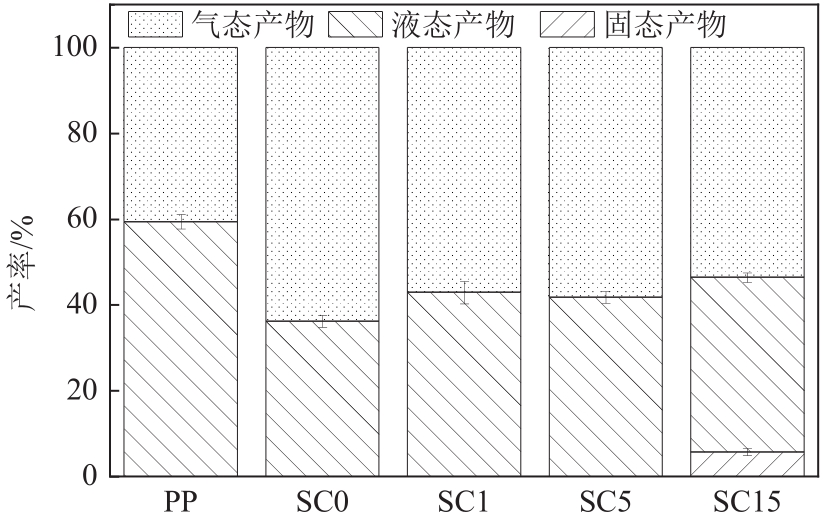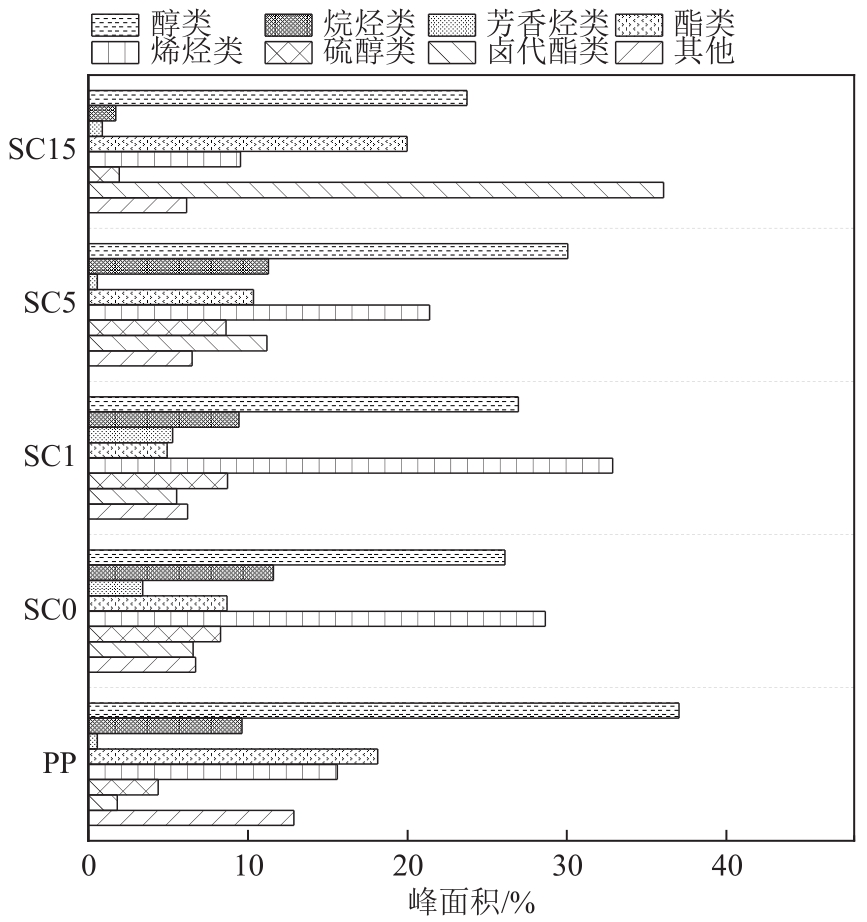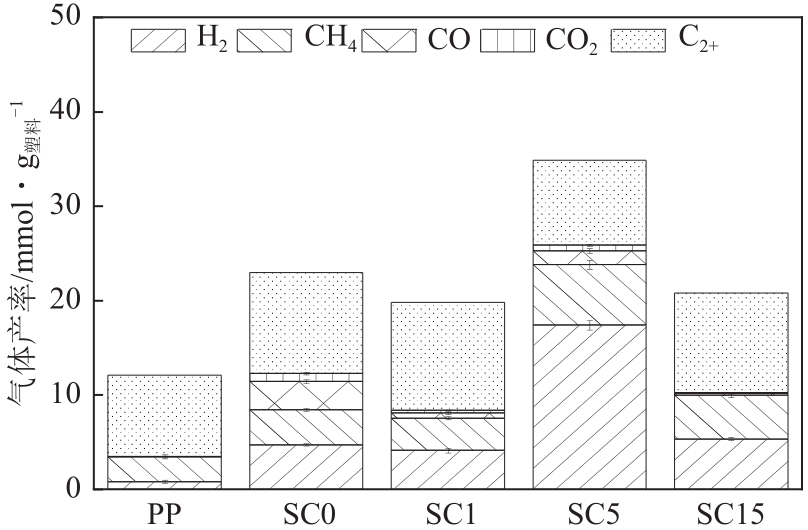Chemical Industry and Engineering Progress ›› 2023, Vol. 42 ›› Issue (2): 631-640.DOI: 10.16085/j.issn.1000-6613.2022-1352
Previous Articles Next Articles
Catalytic pyrolysis of polypropylene plastics and product properties with Fe-loaded sludge biochar
HU Zhaoyan1( ), ZHANG Jingxin1(
), ZHANG Jingxin1( ), HE Yiliang1,2
), HE Yiliang1,2
- 1.China-UK Low Carbon College, Shanghai Jiao Tong University, Shanghai 201306, China
2.School of Environmental Science and Engineering, Shanghai Jiao Tong University, Shanghai 200240, China
-
Received:2022-07-19Revised:2022-11-07Online:2023-03-13Published:2023-02-25 -
Contact:ZHANG Jingxin
Fe负载污泥生物炭催化热解聚丙烯及产物特性
- 1.上海交通大学中英国际低碳学院,上海 201306
2.上海交通大学环境科学与工程学院,上海 200240
-
通讯作者:张景新 -
作者简介:胡兆岩(1998—),男,硕士研究生,研究方向为有机废弃物资源化利用。E-mail:444081248@qq.com。 -
基金资助:国家自然科学基金国际(地区)合作与交流项目(72061127004)
CLC Number:
Cite this article
HU Zhaoyan, ZHANG Jingxin, HE Yiliang. Catalytic pyrolysis of polypropylene plastics and product properties with Fe-loaded sludge biochar[J]. Chemical Industry and Engineering Progress, 2023, 42(2): 631-640.
胡兆岩, 张景新, 何义亮. Fe负载污泥生物炭催化热解聚丙烯及产物特性[J]. 化工进展, 2023, 42(2): 631-640.
share this article
Add to citation manager EndNote|Ris|BibTeX
URL: https://hgjz.cip.com.cn/EN/10.16085/j.issn.1000-6613.2022-1352
| 材料 | 成炭率 /% | 理论载Fe率 /% | 实际载Fe率 /% | Fe负载效率 /% |
|---|---|---|---|---|
| SC0(fresh) | 37.41 | 3.45 | 2.99 | 86.67 |
| SC1(fresh) | 39.40 | 5.54 | 4.92 | 88.81 |
| SC5(fresh) | 41.09 | 12.80 | 12.60 | 98.44 |
| SC15(fresh) | 48.23 | 20.60 | 19.22 | 93.30 |
| 材料 | 成炭率 /% | 理论载Fe率 /% | 实际载Fe率 /% | Fe负载效率 /% |
|---|---|---|---|---|
| SC0(fresh) | 37.41 | 3.45 | 2.99 | 86.67 |
| SC1(fresh) | 39.40 | 5.54 | 4.92 | 88.81 |
| SC5(fresh) | 41.09 | 12.80 | 12.60 | 98.44 |
| SC15(fresh) | 48.23 | 20.60 | 19.22 | 93.30 |
| 材料 | 比表面积 /m2·g-1 | 总孔体积 /cm3·g-1 | 平均孔径 /nm |
|---|---|---|---|
| SC0(fresh) | 40.692 | 0.1840 | 18.0843 |
| SC0 | 58.910 | 0.2476 | 16.8089 |
| SC1 | 55.245 | 0.2269 | 16.4317 |
| SC5 | 225.908 | 0.8773 | 15.5338 |
| SC15 | 14.536 | 0.1204 | 33.1333 |
| 材料 | 比表面积 /m2·g-1 | 总孔体积 /cm3·g-1 | 平均孔径 /nm |
|---|---|---|---|
| SC0(fresh) | 40.692 | 0.1840 | 18.0843 |
| SC0 | 58.910 | 0.2476 | 16.8089 |
| SC1 | 55.245 | 0.2269 | 16.4317 |
| SC5 | 225.908 | 0.8773 | 15.5338 |
| SC15 | 14.536 | 0.1204 | 33.1333 |
| 1 | 马占峰, 姜宛君. 中国塑料加工工业(2020)[J]. 中国塑料, 2021, 35(5): 119-125. |
| MA Zhanfeng, JIANG Wanjun. China plastics industry(2020)[J]. China Plastics, 2021, 35(5): 119-125. | |
| 2 | 谭捷. 聚丙烯(PP).中国化学工业年鉴.[M]. 北京: 中国化工信息中心, 2019: 259-262. |
| TAN Jie. Polypropylene(PP). China chemical industry yearbook[M]. Beijing: China Chemical Information Center, 2019, 259-262. | |
| 3 | 李明丰, 蔡志强, 邹亮, 等. 中国石化废旧塑料化学回收与化学循环技术探索[J]. 中国塑料, 2021, 35(8): 64-76. |
| LI Mingfeng, CAI Zhiqiang, ZOU Liang, et al. Exploration on chemical recovery technology of plastic wastes in Sinopec[J]. China Plastics, 2021, 35(8): 64-76. | |
| 4 | 王金星. 塑料垃圾化学链燃烧控制二𫫇英排放的研究[D]. 武汉: 华中科技大学, 2016. |
| WANG Jinxing. Study on chemical looping combustion of plastic wastes for controlling the emission of PCDD/fs[D]. Wuhan: Huazhong University of Science and Technology, 2016. | |
| 5 | 延雨宸,杨忠芳,余涛.土壤中微塑料的来源、生态环境危害及治理技术[J]. 中国地质, 2022, 49(3): 770-788. |
| YAN Yuchen, YANG Zhongfang, YU Tao. Sources, ecological hazards and treatment technologies of microplastics in soil[J]. Geology in China, 2022, 49(3): 770-788. | |
| 6 | 俞东辉. 废旧塑料热裂解技术的研究[D]. 上海: 华东理工大学, 2012. |
| YU Donghui. Research on pyrolysis of waste plastics recycling technology[D]. Shanghai: East China University of Science and Technology, 2012. | |
| 7 | Sumin PYO, KIM Young Min, PARK Youna, et al. Catalytic pyrolysis of polypropylene over Ga loaded HZSM-5[J]. Journal of Industrial and Engineering Chemistry, 2021, 103: 136-141. |
| 8 | 孙锴. 废塑料催化热解制备芳香烃的研究[D]. 杭州: 浙江大学, 2021. |
| SUN Kai. Study on aromatics production from catalytic pyrolysis of waste plastics[D]. Hangzhou: Zhejiang University, 2021. | |
| 9 | SHEN Yafei. Chars as carbonaceous adsorbents/catalysts for tar elimination during biomass pyrolysis or gasification[J]. Renewable and Sustainable Energy Reviews, 2015, 43: 281-295. |
| 10 | QI Pengyu, CHANG Guozhang, WANG Hongchao, et al. Production of aromatic hydrocarbons by catalytic co-pyrolysis of microalgae and polypropylene using HZSM-5[J]. Journal of Analytical and Applied Pyrolysis, 2018, 136: 178-185. |
| 11 | YAO Dingding, LI He, DAI Yanjun, et al. Impact of temperature on the activity of Fe-Ni catalysts for pyrolysis and decomposition processing of plastic waste[J]. Chemical Engineering Journal, 2021, 408:127268. |
| 12 | Abu EL-RUB Z, BRAMER E A, BREM G. Experimental comparison of biomass chars with other catalysts for tar reduction[J]. Fuel, 2008, 87(10/11): 2243-2252. |
| 13 | WANG Chenxi, LEI Hanwu, KONG Xiao, et al. Catalytic upcycling of waste plastics over nanocellulose derived biochar catalyst for the coupling harvest of hydrogen and liquid fuels[J]. Science of the Total Environment, 2021, 779: 146463. |
| 14 | 胡子健. 中国城市建设统计年鉴[M]. 北京: 中国统计出版社, 2021: 509-511. |
| HU Zijian. China urban construction statistical yearbook[M]. Beijing: China Statistics Press, 2021: 509-511. | |
| 15 | 王琳, 李德彬, 刘子为, 等. 污泥处理处置路径碳排放分析[J]. 中国环境科学, 2022, 42(5): 2404-2412. |
| WANG Lin, LI Debin, LIU Ziwei, et al. Analysis on carbon emission from sludge treatment and disposal[J]. China Environmental Science, 2022, 42(5): 2404-2412. | |
| 16 | CHEN Yidi, WANG Rupeng, DUAN Xiaoguang, et al. Production, properties, and catalytic applications of sludge derived biochar for environmental remediation[J]. Water Research, 2020, 187: 116390. |
| 17 | LIANG Jun, XU Xiaoyun, ZHONG Qijun, et al. Roles of the mineral constituents in sludge-derived biochar in persulfate activation for phenol degradation[J]. Journal of Hazardous Materials, 2020, 398: 122861. |
| 18 | 陆鹏. 废弃物衍生炭基催化剂催化脱除气化焦油的研究[D].杭州: 浙江大学, 2019. |
| LU Peng. Study on catalytic removal of gasification tar by waste derived char catalyst[D]. Hangzhou: Zhejiang University, 2019. | |
| 19 | 姚丁丁. 废塑料催化热解制备富氢气体和碳纳米管的实验研究[D]. 武汉:华中科技大学, 2018. |
| YAO Dingding. Hydrogen rich syngas and carbon nanotubes production from pyrolysis-catalysis of waste plastics[D]. Wuhan: Huazhong University of Science and Technology, 2018. | |
| 20 | 徐永亮. 市政污泥基础特性及低温负压干化技术研究[D]. 镇江: 江苏大学, 2020. |
| XU Yongliang. Municipal sludge basic characteristics and negative pressure in low temperature drying technology research[D]. Zhenjiang: Jiangsu University, 2020. | |
| 21 | 方帅. 地下水厂铁泥制备磁性吸附剂的研究[D].长春: 东北师范大学, 2015. |
| FANG Shuai. Synthesis of magnetic absorbent with iron sludge from groundwater plant[D]. Changchun: Northeast Normal University, 2015. | |
| 22 | SUN Kai, HUANG Qunxing, Mujahid ALI, et al. Producing aromatic-enriched oil from mixed plastics using activated biochar as catalyst[J]. Energy & Fuels, 2018, 32(4) : 5471-5479. |
| 23 | 邹意义, 袁怡, 沈涛, 等. FeCl3改性污泥生物炭对水中吡虫啉的吸附性能研究[J]. 环境科学学报, 2021, 41(9): 3478-3486. |
| ZOU Yiyi, YUAN Yi, SHEN Tao, et al. Study on the adsorptive performance of imidacloprid from aqueous solution by FeCl3 modified biochar derived from sludge[J]. Acta Scientiae Circumstantiae, 2021, 41(9): 3478-3486. | |
| 24 | 王烽圣, 许晓毅, 时和敏, 等. Fe2+改性菖蒲生物炭制备及对水中磷的吸附特性[J]. 环境工程学报, 2021, 15(11): 3493-3503. |
| WANG Fengsheng, XU Xiaoyi, SHI Hemin, et al. Preparation of Fe2+ modified calamus biochar and its adsorption characteristics towards phosphorus from aqueous solutions[J]. Chinese Journal of Environmental Engineering, 2021, 15(11): 3493-3503. | |
| 25 | KEILUWEIT Marco, NICO Peter S, JOHNSON Mark G, et al. Dynamic molecular structure of plant biomass-derived black carbon (biochar)[J]. Environmental Science & Technology, 2010, 44(4): 1247-1253. |
| 26 | KIM Young Inn, HATFIELD William E. Electrical, magnetic and spectroscopic properties of tetrathiafulvalene charge transfer compounds with iron, ruthenium, rhodium and iridium halides[J]. Inorganica Chimica Acta, 1991, 188(1):15-24. |
| 27 | HAWN David D, DEKOVEN Benjamin M. Deconvolution as a correction for photoelectron inelastic energy losses in the core level XPS spectra of iron oxides[J]. Surface and Interface Analysis, 1987, 10(2/3): 63-74. |
| 28 | TERZYK Artur P. The influence of activated carbon surface chemical composition on the adsorption of acetaminophen (paracetamol) in vitro: Part Ⅱ. TG, FTIR, and XPS analysis of carbons and the temperature dependence of adsorption kinetics at the neutral pH[J]. Colloids and Surfaces A: Physicochemical and Engineering Aspects, 2001, 177(1): 23-45. |
| 29 | 柏珊珊. 铁改性稻壳生物炭对水中SMT的吸附效能及作用机制[D]. 哈尔滨: 哈尔滨工业大学, 2021. |
| BAI Shanshan. Adsorption efficiency and mechanism of iron-modified rice husk biochar for SMT in water[D]. Harbin: Harbin Institute of Technology, 2021. | |
| 30 | GONG Jiang, LIU Jie, WAN Dong, et al. Catalytic carbonization of polypropylene by the combined catalysis of activated carbon with Ni2O3 into carbon nanotubes and its mechanism[J]. Applied Catalysis A: General, 2012, 449: 112-120. |
| 31 | MOLINER R, SUELVES I, LÁZARO M J, et al. Thermocatalytic decomposition of methane over activated carbons: Influence of textural properties and surface chemistry[J]. International Journal of Hydrogen Energy, 2005, 30(3): 293-300. |
| 32 | ZHANG Li, YAO Zonglu, ZHAO Lixin, et al. Synthesis and characterization of different activated biochar catalysts for removal of biomass pyrolysis tar[J]. Energy, 2021, 232: 120927. |
| 33 | 庞赟佶, 刘心明, 陈义胜, 等. 生物炭负载Ca和Fe催化玉米秸秆热解挥发分重整提高产气率[J]. 农业工程学报, 2019, 35(3): 211-217. |
| PANG Yunji, LIU Xinming, CHEN Yisheng, et al. Catalytic reforming of volatiles in pyrolysis by using biomass carbon particle loading Ca and Fe and improving biogas yield[J]. Transactions of the Chinese Society of Agricultural Engineering, 2019, 35(3): 211-217. | |
| 34 | ZHANG Ming, LIN Kun, LI Xiaodian, et al. Removal of phosphate from water by paper mill sludge biochar[J]. Environmental Pollution, 2022, 293: 118521. |
| 35 | LIU Mengjie, LI Ronghua, WANG Jingwen, et al. Recovery of phosphate from aqueous solution by dewatered dry sludge biochar and its feasibility in fertilizer use[J]. Science of the Total Environment, 2022, 814: 152752. |
| 36 | 邱鑫, 李方圆, 张仕鸣, 等. CaCO3微粉对刚玉质弥散型透气砖性能的影响[J]. 硅酸盐通报, 2021, 40(10): 3279-3284. |
| QIU Xin, LI Fangyuan, ZHANG Shiming, et al. Effect of CaCO3 micropowder on properties of corundum based porous purging plug[J]. Bulletin of the Chinese Ceramic Society, 2021, 40(10): 3279-3284. | |
| 37 | LI Bin, MAGOUA MBEUGANG Christian Fabrice, HUANG Yong, et al. A review of CaO based catalysts for tar removal during biomass gasification[J]. Energy, 2022, 244: 123172. |
| 38 | 贾晋炜. 生活垃圾和农业秸秆共热解及液体产物分离研究[D].北京: 中国矿业大学(北京), 2013. |
| JIA Jinwei. Co-pyrolysis of municipal solid waste with agricultural stalk and separation of pyrolysis liquid[D]. Beijing: China University of Mining & Technology,Beijing, 2013. | |
| 39 | 庞赟佶, 孟浩楠, 陈义胜, 等. Ca/Fe强化生物炭催化秸秆热解挥发分蒸汽重整产氢[J].农业工程学报, 2019, 35(22): 187-192. |
| PANG Yunji, MENG Haonan, CHEN Yisheng, et al. Biomass charcoal catalytic with Ca/Fe enhancing hydrogen production by pyrolysis volatile steam reforming[J]. Transactions of the Chinese Society of Agricultural Engineering, 2019, 35(22): 187-192. | |
| 40 | 许嘉, 许月, 陈俊俊, 等. 生物质炭对聚丙烯热解焦油降解作用分析[J]. 石油化工, 2019, 48(3): 273-278. |
| XU Jia, XU Yue, CHEN Junjun, et al. Degradation analysis of polypropylene pyrolysis tar by carbon-based catalyst[J]. Petrochemical Technology, 2019, 48(3): 273-278. | |
| 41 | 冯时宇, 李洋, 李凯, 等. 塑料废弃物热催化制备碳纳米管的研究进展[J]. 环境工程, 2021, 39(4): 107-114. |
| FENG Shiyu, LI Yang, LI Kai, et al. Progress in preparation of carbon nanotubes by thermal catalysis of waste plastics[J]. Environmental Engineering, 2021, 39(4): 107-114. | |
| 42 | LI Kaixin, LEI Junxi, YUAN Guoan, et al. Fe-, Ti-, Zr- and Al-pillared clays for efficient catalytic pyrolysis of mixed plastics[J]. Chemical Engineering Journal, 2017, 317: 800-809. |
| [1] | YANG Xiazhen, PENG Yifan, LIU Huazhang, HUO Chao. Regulation of active phase of fused iron catalyst and its catalytic performance of Fischer-Tropsch synthesis [J]. Chemical Industry and Engineering Progress, 2023, 42(S1): 310-318. |
| [2] | DAI Huantao, CAO Lingyu, YOU Xinxiu, XU Haoliang, WANG Tao, XIANG Wei, ZHANG Xueyang. Adsorption properties of CO2 on pomelo peel biochar impregnated by lignin [J]. Chemical Industry and Engineering Progress, 2023, 42(S1): 356-363. |
| [3] | XU Zhongshuo, ZHOU Panpan, WANG Yuhui, HUANG Wei, SONG Xinshan. Advances in sulfur iron ore mediated autotrophic denitrification [J]. Chemical Industry and Engineering Progress, 2023, 42(9): 4863-4871. |
| [4] | SHAO Zhiguo, REN Wen, XU Shipei, NIE Fan, XU Yu, LIU Longjie, XIE Shuixiang, LI Xingchun, WANG Qingji, XIE Jiacai. Influence of final temperature on the distribution and characteristics of oil-based drilling cuttings pyrolysis products [J]. Chemical Industry and Engineering Progress, 2023, 42(9): 4929-4938. |
| [5] | LI Zhiyuan, HUANG Yaji, ZHAO Jiaqi, YU Mengzhu, ZHU Zhicheng, CHENG Haoqiang, SHI Hao, WANG Sheng. Characterization of heavy metals during co-pyrolysis of sludge with PVC [J]. Chemical Industry and Engineering Progress, 2023, 42(9): 4947-4956. |
| [6] | SHI Tianxi, SHI Yonghui, WU Xinying, ZHANG Yihao, QIN Zhe, ZHAO Chunxia, LU Da. Effects of Fe2+ on the performance of Anammox EGSB reactor [J]. Chemical Industry and Engineering Progress, 2023, 42(9): 5003-5010. |
| [7] | WANG Haoran, YIN Quanyu, FANG Ming, HOU Jianlin, LI Jun, HE Bin, ZHANG Mingyue. Optimization of near critical-water treatment process of tobacco stems [J]. Chemical Industry and Engineering Progress, 2023, 42(9): 5019-5027. |
| [8] | GAO Cong, CHEN Chenghu, CHEN Xiulai, LIU Liming. Progress and challenges of engineering microorganisms to produce biobased monomers [J]. Chemical Industry and Engineering Progress, 2023, 42(8): 4123-4135. |
| [9] | JIANG Jing, CHEN Xiaoyu, ZHANG Ruiyan, SHENG Guangyao. Research progress of manganese-loaded biochar preparation and its application in environmental remediation [J]. Chemical Industry and Engineering Progress, 2023, 42(8): 4385-4397. |
| [10] | LI Haidong, YANG Yuankun, GUO Shushu, WANG Benjin, YUE Tingting, FU Kaibin, WANG Zhe, HE Shouqin, YAO Jun, CHEN Shu. Effect of carbonization and calcination temperature on As(Ⅲ) removal performance of plant-based Fe-C microelectrolytic materials [J]. Chemical Industry and Engineering Progress, 2023, 42(7): 3652-3663. |
| [11] | LI Yanling, ZHUO Zhen, CHI Liang, CHEN Xi, SUN Tanglei, LIU Peng, LEI Tingzhou. Research progress on preparation and application of nitrogen-doped biochar [J]. Chemical Industry and Engineering Progress, 2023, 42(7): 3720-3735. |
| [12] | YANG Ziyu, ZHU Ling, WANG Wenlong, YU Chaofan, SANG Yimin. Research and application progress of smoldering combustion technology for oily sludge [J]. Chemical Industry and Engineering Progress, 2023, 42(7): 3760-3769. |
| [13] | YAO Liming, WANG Yazhuo, FAN Honggang, GU Qing, YUAN Haoran, CHEN Yong. Treatment status of kitchen waste and its research progress of pyrolysis technology [J]. Chemical Industry and Engineering Progress, 2023, 42(7): 3791-3801. |
| [14] | ZHANG Shan, ZHONG Zhaoping, YANG Yuxuan, DU Haoran, LI Qian. Enrichment of heavy metals in pyrolysis of municipal solid waste by phosphate modified kaolin [J]. Chemical Industry and Engineering Progress, 2023, 42(7): 3893-3903. |
| [15] | YANG Jingying, SHI Wansheng, HUANG Zhenxing, XIE Lijuan, ZHAO Mingxing, RUAN Wenquan. Research progress on the preparation of modified nano zero-valent iron materials [J]. Chemical Industry and Engineering Progress, 2023, 42(6): 2975-2986. |
| Viewed | ||||||
|
Full text |
|
|||||
|
Abstract |
|
|||||








